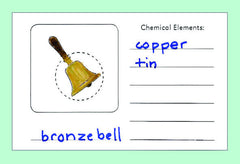Helping children grasp the reality of chemical elements March 19 2016, 0 Comments
The first time I introduced children to the chemical elements, I wanted to give them a sense of where they might find these substances, either as single elements or in combination with others. Laying out the periodic table is one experience with the elements, but it is quite abstract and disconnected with everyday life. I wanted to help children learn about the elements in common substances, items they could encounter and experience.
I made a set of cards that had pictures of items, and I listed the major elements in each one on the back of the card. To let you know how long ago that was, I printed the lists of elements with a dot matrix printer and an Apple II computer. Fast forward a decade or so, and Carolyn Jones of InPrint for Children was designing a new series of materials for study of matter and atoms in Montessori elementary classrooms. We discussed the idea of a card set that shows common objects and their elements. She took the idea and produced an attractive set of cards that she calls “Elements Around Us.” Presently, only Big Picture Science sells this set.

“Elements Around Us” has photos of 20 objects. The set includes two copies of each card, one to leave whole with text that tells the elements, and one to cut apart for matching. We intentionally used some substances to simulate thinking. The photo of a cotton towel (which is mainly cellulose) and table sugar both say “This is composed of carbon, oxygen, and hydrogen.” Cellulose is a macromolecule that is built of sugar molecules. These cards lead to the concept that elements can be joined in many ways to make different substances. The card that shows gold colored coins lists no gold as an ingredient. There are cards for carbon in the form of graphite and of diamond.
After children have worked with the cards, they are often interested in doing more. The “Elements Around Us” set has a black line master called a replicard, which you can copy for children so they can make their own booklets. They can color the outline drawing and write the elements. There are two blanks for children to draw their own object and research its elements.

Elementary children who are past the stage for card materials or who want to pursue the idea further will likely enjoy How to Make a Universe with 92 Ingredients, a book by Adrian Dingle. The book, Planet in a Pebble, by Jan Zalasiewicz, begins with a chapter on the elements in a common beach pebble. This book is for adult general readers, but selections from it can be read to older children or read by secondary students.
Happy element hunting!
